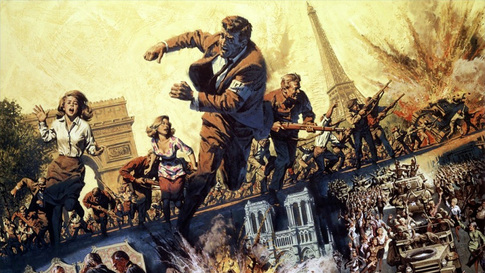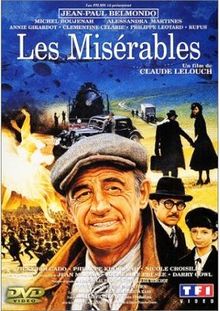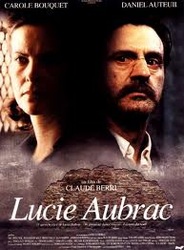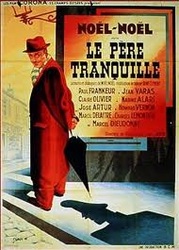Some cinematic approaches to the French Resistance
French Resistance: still a controversial issue almost seven decades later
Movies about the French Resistance have played a major role in determining the way that movement has been perceived in France and even in the wider world. For decades movies presented the Resistance in what historians in the 21st century now classify as a distorted and politicised series of myths (see column below left). This traditional but mythical account of a brave national struggle to overcome hated Nazi oppressors has become central to modern French identity. It is only now being overturned
Myths about the French ResistanceFor many years, movies about the French Resistance portrayed it as having several crucial features. As recent historians e.g. Robert Gildea have pointed out, these alleged characteristics are largely the results of mythologising by Charles de Gaulle and his political supporters. The reality of the nature of the Resistance has also been distorted by accounts produced by French Communists, bitter opponents of the Gaullists.
• the Resistance was a very popular movement, large in numbers and supported by most French people; •it was a highly effective operation and well organized organization which was a constant thorn in the side of German Occupation forces; • Resistance forces relied mainly on aggressive armed actions against the German Occupiers, inflicting considerable damage and disruption. • the Resistance was a unified force, combining French people of all shades of social class and political belief; • it worked willingly under the forceful leadership of Charles de Gaulle, head of the Free French based in London, and also with various Allied military authorities |
New Views about the French ResistanceSince the late 1960s several movies anticipated recent revisionist views that have demolished many myths about the Resistance:
• the Resistance was NOT a widespread and popular movement - only a very small proportion of the population participated; • many members of the Resistance were betrayed by their own countrymen. most of whom accepted German occupation / influence • overall, the Resistance inflicted comparatively little damage on German forces in France; • most Resistance activity was small-scale in nature, consisting largely of spying and sabotage; • it was a bitterly divided movement, split along political and ideological lines, constantly squabbling • de Gaulle's attitude towards the movement was ambiguous; he was regarded with suspicion by many in the Resistance; • for many in the Resistance, the movement existed not only to defeat the Germans. It was also intended to prepare the way for a completely different postwar French social and political system. |
A photo that reveals the controversy about the French Resistance
This photo shows Charles de Gaulle heading a parade down the Champs d'Elysee just after Allied troops liberated Paris. Many in the crowd were members of the Resistance. Initially this image appears to support the traditional view of the Resistance movement as popular and united: prominently located in the front are Georges Bidault (head of the National Council of the Resistance) and Georges Dukson, a twenty-two year old black Frenchman who had fought in Paris for over a week with his resistance unit. Dukson even captured a German tank during the fighting and had become something of a local hero.
Dukson wasn't supposed to be so conspicuously placed in the parade - he apparently decided spontaneously to join the front ranks to win a bet. However, he didn't stay there very long -minutes after the photo was taken, he was removed - at gunpoint. De Gaulle wanted to be in complete control of events. He also wanted the parade to be an orderly, dignified march, not the spontaneous eruption of largely civilian triumph that it quickly became. Dukson's forced removal from the parade -after de Gaulle had ordered him to stop smoking - reveals the widening division between the Gaullists and left-wing elements within the Resistance. Within weeks Dukson was dead. He was found selling looted German goods on the black market, arrested by orders of the Paris Military Governor, and shot while trying to escape, dying in hospital of his wounds. [See Matthew Webb, The Resistance: the French Fight Against the Nazis (London: 2009),p.269-70; 381]
The apparent harmony and unity of liberated Paris that the photo appears to show was in fact a facade that concealed the longstanding divisions and rivalries between the various French liberation groups. These animosities and the sense of disillusion that accompanied them would eventually become the inspiration for several outstanding movies about the Resistance.
Dukson wasn't supposed to be so conspicuously placed in the parade - he apparently decided spontaneously to join the front ranks to win a bet. However, he didn't stay there very long -minutes after the photo was taken, he was removed - at gunpoint. De Gaulle wanted to be in complete control of events. He also wanted the parade to be an orderly, dignified march, not the spontaneous eruption of largely civilian triumph that it quickly became. Dukson's forced removal from the parade -after de Gaulle had ordered him to stop smoking - reveals the widening division between the Gaullists and left-wing elements within the Resistance. Within weeks Dukson was dead. He was found selling looted German goods on the black market, arrested by orders of the Paris Military Governor, and shot while trying to escape, dying in hospital of his wounds. [See Matthew Webb, The Resistance: the French Fight Against the Nazis (London: 2009),p.269-70; 381]
The apparent harmony and unity of liberated Paris that the photo appears to show was in fact a facade that concealed the longstanding divisions and rivalries between the various French liberation groups. These animosities and the sense of disillusion that accompanied them would eventually become the inspiration for several outstanding movies about the Resistance.
Some other movies based on the French Resistance
A once forbidden topic becomes a hit French TV series
The popularity of a current French tv series, Un village francaise, which is based on the lives of the inhabitants of a fictional French village under German occupation, shows that after decades of neglect what was a controversial issue, shunted aside by politicians, academics and public alike, has finally become an acceptable topic for prime-time French television. Although the series veers at times into soap opera territory, it also deals effectively with such key problems as collaboration and resistance, relationships (romantic and otherwise) with the German occupying forces, and awareness of what was happening to local Jewish families and the consequences.




























